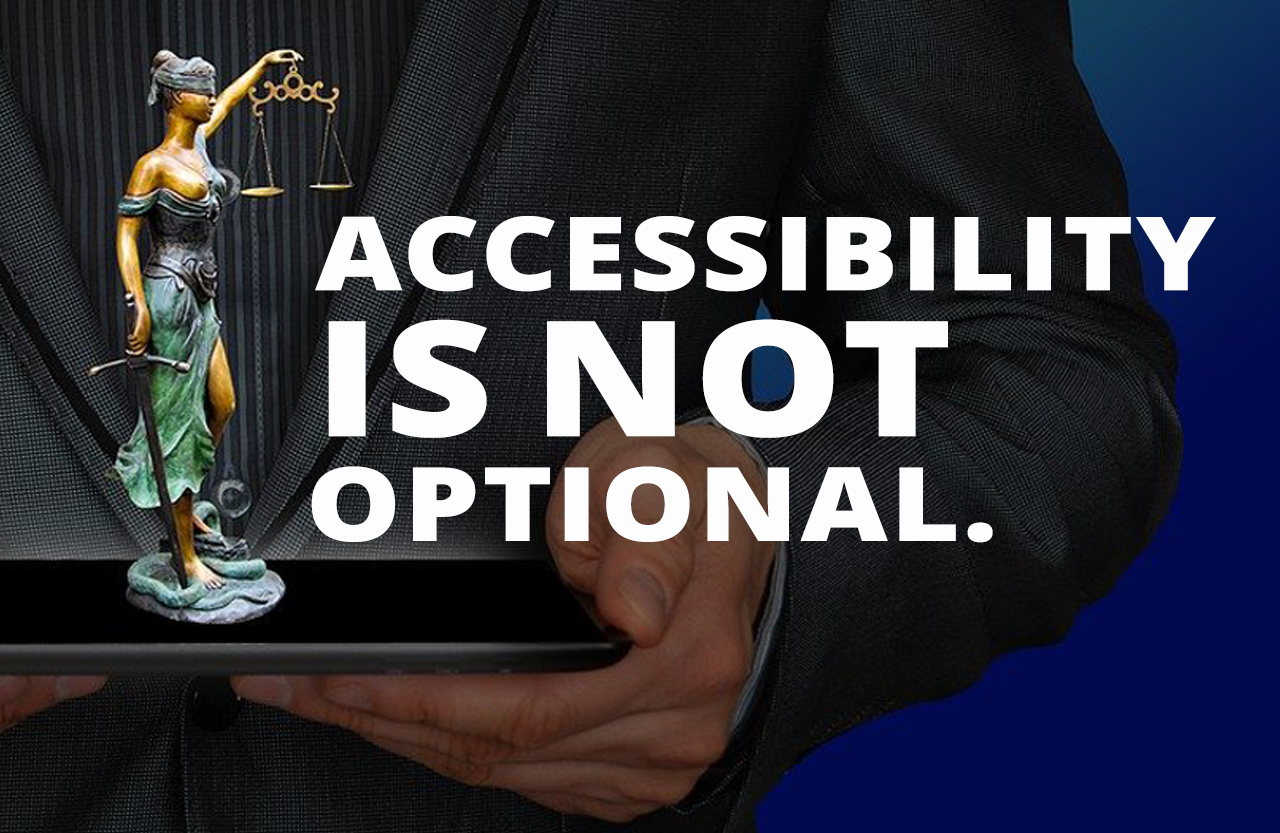
At the end of June 2025, the accessibility law concerning products and services came into effect in Hungary and across the EU. One of the presentations at the web accessibility meetup addressed this topic.
Dr. Péter Kemény, an accessibility expert certified as an ADS (Accessible Document Specialist), came from Egészségért Kft. and one of the most renowned accessibility-focused foundations, the Funka Foundation. He entered the world of accessibility nearly ten years ago when he was directly involved on behalf of the European Commission in developing the web accessibility directive and its related regulations. You could say he was at the heart of it all. Since then, he has been passionately engaged in accessibility, complementing his legal background with technical knowledge. His specialty is document accessibility, which places him among the few experts in Hungary working in this field. His presentation primarily focused on the legal aspects.
The beginning of digital accessibility in Europe
Who needs to deal with it?
What needs to be done? And how?
Let’s start with a brief overview of how it all began. Fundamentally, we had a Disability Act from 1998 and an Equal Opportunities Act from 2003, also known as the Act on Equal Treatment. At that time, the approach was that equal opportunities for people with disabilities had to be ensured. Any area where people were disadvantaged due to their disability could be addressed from this perspective or challenged legally on this basis.
In 2006, the United Nations Convention on the Rights of Persons with Disabilities was adopted, and Hungary ratified it already in 2007. This convention is notable for being the first UN treaty to address accessibility and for having been ratified in record time by a record number of countries. Following this, the legal framework began to shift, and laws started emerging that directly addressed accessibility and social inclusion.
The essence of these laws is that people with disabilities should not be viewed as poor souls unable to do what the majority can. The new perspective is that it’s not the person who is disabled, but their environment that prevents them from doing what others can. This idea is the foundation of accessibility.
After the European regulations were introduced, Hungary also developed its national regulations. The law on accessibility for the public sector was enacted in 2018, and the law concerning the accessibility of certain products and services followed in 2022 (again, based on a European directive). The latter came into effect on June 28.

It won’t affect me… Oh yes, it will!
In terms of services, electronic communications (internet, phone), digital TV, and streaming services like Netflix and HBO will all be affected. Within passenger transport, the law applies to digital services: websites that provide information, mobile applications, and services that enable the purchase of electronic tickets. Furthermore, the law also covers retail banking services (everyone uses a bank), all forms of e-commerce, and e-books themselves.
The new regulation covers the entire supply chain. It’s not just the manufacturer who must ensure accessibility or accessible products, but also authorized representatives or importers, for instance. In Europe—since the regulation is based on a European directive—it will not be permissible after 2025 to distribute non-accessible products or services listed in the law, even if those products or services come from outside of Europe.
When does the
accessibility law take effect?
It applies from June 28, 2025 and only to products and services placed on the market after that date. This will result in a transitional period where both accessible and non-accessible products and services coexist. However, over time, non-accessible products and services will phase out, and everything within the scope of the law will be covered.
There are areas related to products and services that require significant investment, and it would be unreasonable to demand that “from now on, within half a year or a year” they must be made accessible. For example, products used in the provision of services have been granted a 5-year grace period, as have existing service contracts.
User interfaces for accessibility
There are requirements for both the user interface and its functions. For example, there should be sufficient and flexible time available to complete an activity, and there must be alternative identification options besides biometric authentication. In the case of voice-based communication, there must also be an alternative form that can be perceived through another sensory channel. It must also be possible to inform the user or consumer about the accessibility features of the product or service, and how it is compatible with assistive and supportive technologies.
Enforcement and implementation
of accessibility requirements
The regulation defines the requirements on three levels: general, product- and service-specific and according to the European standard EN 301 549.
Compliance with accessibility requirements is not just a recommendation but a legal obligation. Its enforcement takes place through several steps and involves multiple actors to ensure that products and services are genuinely accessible and usable by everyone, including people with disabilities.
First, economic operators—whether manufacturers or service providers—are required to assess whether the products and services they offer comply with accessibility requirements. As a result, they must issue a declaration of conformity, which must be made publicly available in an accessible format.
Compliant products must bear the CE marking, which can only be used if the product meets the prescribed accessibility requirements. This marking also serves as proof of the product’s lawful distribution and conformity.
Market surveillance and enforcement are carried out by various sector-specific authorities. In Hungary, for example, the consumer protection authority is responsible for this task for certain products and services. These bodies are tasked with monitoring whether economic operators are actually complying with the legal regulations. It is important to note that individuals, as well as organizations representing them or people with disabilities, can file legal complaints against manufacturers, service providers, or other economic actors if they fail to meet accessibility requirements.
The authorities also have the power to impose sanctions. The first step is usually a formal notice requiring the operator to remedy the accessibility deficiency. If this does not happen, the authority may decide to prohibit the distribution of the product, restrict its sale, or even mandate a recall. In addition, financial penalties may be imposed, ranging from 15,000 forints to as much as 500 million forints.

The limits of accessibility: obligations and exceptions
Scope of accessibility requirements
The European Union’s accessibility regulation specifically applies to products and services used by consumers—that is, private end users. This means that the legislation does not extend to products and services used in a B2B (business-to-business) environment.
From the perspective of digital presence, there is an important distinction compared to the public sector regulation, which has already been in effect for some time. The new regulation does not follow the logic of the web accessibility directive, under which all public sector bodies are required to make all their websites and mobile applications accessible. Instead, the approach is much more targeted: the obligation applies only to those websites and mobile applications that are connected to products or services falling under the scope of the regulation and that support their use or provide information about them to consumers.
"Disproportionate burden"
Accessibility is mandatory—except when it would impose a disproportionate burden. This applies when the necessary measures—such as changes to manufacturing, distribution, or import—would incur costs that are not proportionate to the expected benefit for consumers. The regulation sets out a detailed procedure for assessing disproportionality, and its central principle is that the exemption should only go as far as the burden is truly disproportionate. In other words, difficulties alone are not sufficient grounds to avoid accessibility obligations.
A clear, though extreme, example helps illustrate this concept: imagine a highly specialized product that would typically be used by only five people in an entire country, and it is known that none of them currently lives with a disability. In this case—at that specific point in time—it would be considered a disproportionate burden to require full accessibility from the manufacturer, especially if it would involve significant additional costs.
Furthermore, accessibility is not mandatory if it would alter the fundamental nature of the product—for example, if larger buttons on a small-sized phone would defeat its entire design concept. But even here, the exemption only applies to those functions where accessibility would require a fundamental change in essential characteristics.
Also exempt are businesses with fewer than ten employees or with annual turnover or balance sheet total under two million euros. However, since the overarching goal is to maximize access for people with disabilities, all organizations are encouraged to implement accessibility in a reasonable and practical way.
Business obligations
and control mechanisms
Microenterprises and accessibility – how does the regulation affect educational materials?
The basic principle of the regulation is that microenterprises are generally exempt from accessibility obligations. This means that a digital educational material created and directly distributed by a microenterprise does not need to be accessible on its own.
However, one important and forward-looking element of the regulation is that it covers the entire supply chain. This means that if a larger service provider purchases educational material created by a microenterprise and offers it as part of its own services, the accessibility obligation does apply. In this case, the digital content reaches a broader audience and has a greater impact on the general public.
This regulatory logic essentially uses market mechanisms to encourage smaller players to ensure accessibility. A microenterprise cannot afford to ignore this aspect, as larger service providers simply won’t buy a product that doesn’t meet the requirements.
This operating model highlights one of the regulation’s key strengths: it ensures the enforcement of accessibility on the digital product and service market not only directly, but also indirectly.
How will the new law ensure
accessibility enforcement in the future?
Based on my personal experience, the field of web accessibility already paints a positive picture regarding both Hungarian and European practices. In Hungary, the Governmental Agency for IT Development (KIFÜ) is responsible for monitoring the accessibility of public administration websites and mobile applications. Experience shows that the agency works in a committed and supportive manner with public sector organizations.
This attitude is not unique—across Europe, it is also the case that authorities responsible for checking web accessibility take their tasks seriously while helping affected organizations comply with the requirements. This indicates that the system works and provides real support for enforcing regulations.
Accessibility market surveillance for products and services is also well-structured. As mentioned earlier, different authorities are responsible depending on the type of product or service.
Government Decree 605/2022 provides detailed regulations on which authority is responsible for which area. For example, the National Media and Infocommunications Authority (NMHH) oversees broadcasting and electronic communications, while the consumer protection authority is responsible, among other things, for the compliance of payment terminals. One of the most positive aspects of this system is that supervisory responsibilities have been assigned to organizations that already had prior experience with the respective product or service categories. This ensures that these authorities possess the necessary expertise and, moving forward, will assess accessibility features with the same professionalism and standards as they previously did for other compliance requirements.
Thanks to the professional insight of Dr. Péter Kemény, the article provided a look into how accessibility regulation is evolving at both the national and EU level, and what practical consequences businesses need to prepare for.
Accessibility is not just a legal obligation—it is increasingly becoming a fundamental principle.